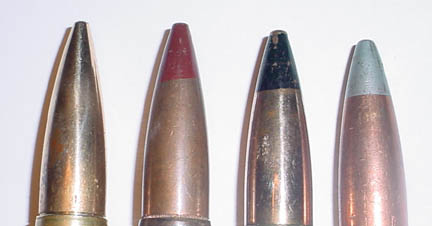
Browning Machinegun Caliber .50 HB, M-2 |
Unless otherwise noted, the information on this page is extracted from HQ, Department of the Army Field Manual FM 23-65, Browning Machinegun Caliber .50 HB, M2, dated May 1972. It is believed that the technical data is unchanged from World War II. Description: The Browning machinegun, caliber .50 HB, M2, is a belt-fed, recoil-operated, air-cooled, crew-operated machinegun. The gun is capable of single-shot, as well as automatic fire. General Data: Weight of receiver group.............................................................60 lb. Weight of barrel..........................................................................24 lb. (approx.) Weight of tripod mount M3 (w/traversing and elevating mechanism and pintle w/bolt....................................................44 lb. Total weight of gun, complete, on tripod mount, M3.....................128 lb. (approx.) Maximum range (M2 Ball)...........................................................6,800 meters (approx) Maximum effective range.............................................................1,830 meters Rates of fire: Sustained....................................................................................40 rd. or less per min. Rapid..........................................................................................40 rd. or more per min Cyclc rate of fire..........................................................................450-550 rd. per min. Muzzle velocity (M2 ball)............................................................3,050 ft per sec (2,080 mph) Length of gun, overall..................................................................65 in. (approx.) Length of barrel...........................................................................45 in. Ammunition: General: The caliber .50 cartridge consists of a cartridge case, primer, propelling charge, and the bullet. The term buller refers only to the small-arms projectile. The term "ball" was originally used to describe the ball-shaped bullet of early small-arms ammunition. The term "ball ammunition" now refers to a cartridge having a bullet that has a metallic jacket, filled only with lead. Classification: Based on use, the principal classifications of the several types of ammunition used with the machinegun are as follows: a. Ball. For use in marksmanship training, against personnel, and light material targets. b. Tracer. To aid in observing fire. Secondary purposes are for incendiary effect and for signalling. c. Armor-piercing. For use against armored aircraft and lightly armored vehicles, concrete shelters, and other bullet-resisting targets. d. Incendiary. For incendiary effect, especially against aircraft. e. Armor-piercing-Incendiary (AP-I). For combined armor-piercing and incendiary effect. f. Armor-piercing-Incendiary-Tracer. For combined armor-piercing and incendiary effect, with the additional tracer feature. g. Blank. For simulated fire (contains no bullet.) h. High-pressure test. For use only in proof firing of weapons and barrels. i. Dummy. For training (completely inert.) Identification: Ammunition marking. Colors painted on the tips of bullets aid in identification of the various types of ammunition. The following colors are used: Type of cartridge Color of tip of bullet Ball, M2.............................................................None Tracer, M1.........................................................Red, maroon, or orange tip Armor-piercing, M2...........................................Black tip Incendiary, M1...................................................Blue tip, light blue ring with blue tip Armor-piercing-incendiary, M8..........................Aluminum colored tip, or aluminum ring with blue tip Armor-piercing-incendiary-tracer, M20..............Aluminum ring with red tip Blank.................................................................No bullet Dummy..............................................................None, holes in cartridge case High-pressure-test, M1.......................................None, tinned cartridge case .50 caliber bullets, left to right: Ball, tracer, armor-piercing, armor-piercing-incendiary. Miscellaneous Ammunition Data: a. The cartridge, ball, caliber .50, M2 is about 5-1/2 inches long and its bullet is about 2-1/2 inches long. The cartridge weighs 1,813 grains; its case weights 850 grains, the powder charge weighs 235 grains, the primer 19.06 grains, and the bullet 709.5 grains. b. The following chart lists the maximum penetration in inches for armor-piercing cartridge, calier .50, M2, fired from the 45 -inch barrel (muzzle velocity 2935 feet per second): Material Inches at: 200 M 600 M 1500 M Armor plate (homogeneous) 1.0 0.7 0.3 Armor plate (face-hardened) 0.9 0.5 0.2 Sand (100 lb dry wt/cu ft) 14 12 16 Clay (100 lb dry wt/cu ft) 28 27 21 c. The following chart lists the maximum penetration in inches for ball cartridge, caaliber .50, M2, fired from the 45-inch barrel (muzzle velocity 2,935 feet per second): Material Inches at: 200 M 600 M 1500 M Sand (100 lb dry wt/cu ft) 14 12 6 Clay (100 lb dry wt/cu ft) 28 26 21 Concrete 2 1 1 |
